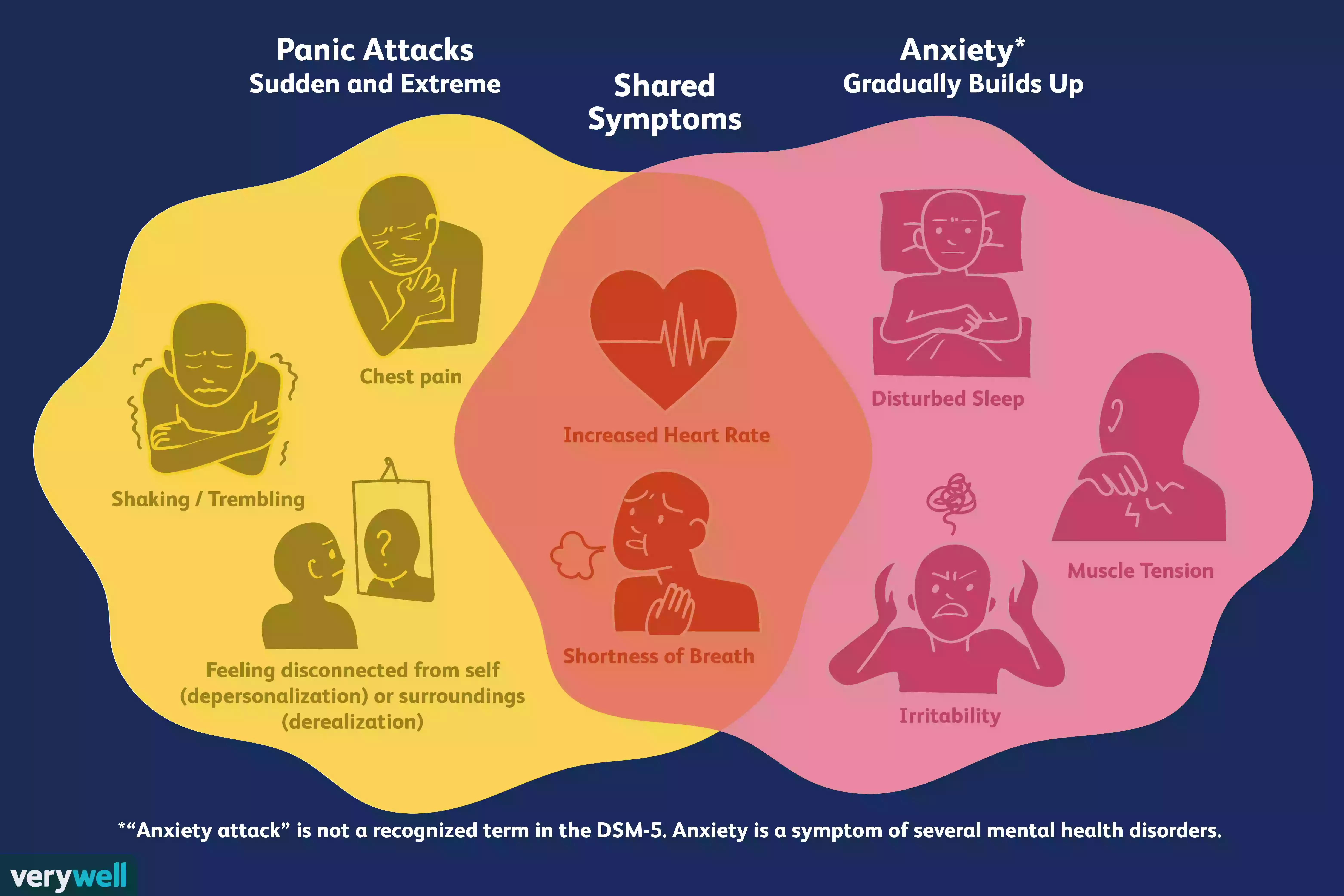How to Talk to Anyone (Junior Talker #5) by DeYtH Banger (you can read anyone TXT) 📖

- Author: DeYtH Banger
Book online «How to Talk to Anyone (Junior Talker #5) by DeYtH Banger (you can read anyone TXT) 📖». Author DeYtH Banger
By Sheryl Ankrom
You might hear the terms anxiety attack and panic attack used interchangeably as if they mean the same thing. In fact, panic and anxiety have different features, and behavioral health professionals use the terms for specific symptoms and disorders.
Panic attacks are often associated with sudden fear and anxiety with high-stress levels or excessive worrying. Some of the symptoms are similar, including a rapid heartbeat, shortness of breath, and dizziness. Each also has other symptoms that are unique.
Everyone can experience panic attacks and anxiety, they are part of the emotional and protective responses hardwired into the human body. Its when either occurs frequently that there is cause for concern. No matter which you experience, it's important to understand their definitions, symptoms, and treatments.

Illustration by Joshua Seong. © Verywell, 2018.
Clinical Differences
Professionals who treat mental health conditions base a diagnosis on definitions found in the "Diagnostic and Statistical Manual of Mental Disorders, 5th edition," known as the DSM-5. Though anxiety and panic attacks may feel the same at times, the subtle differences outlined in this handbook help identify each.
The DSM-5 uses the term panic attack to describe the hallmark features associated with the condition known as panic disorder. However, panic attacks may occur in other psychiatric disorders and it is possible to have a panic attack if you have no disorder.
The term “anxiety attack” is not defined in the DSM-5. Rather, "anxiety" is used to describe a core feature of several illnesses identified under the headings of anxiety disorders, obsessive-compulsive disorders, and trauma- and stressor-related disorders. Some of the most common disorders under these three headings include:
Panic disorder Agoraphobia without history of panic disorder Specific phobia Social anxiety disorder Separation anxiety disorder Obsessive-compulsive disorder (OCD) Post-traumatic stress disorder (PTSD) Generalized anxiety disorder (GAD)
The differences between panic and anxiety are best described in terms of the intensity of the symptoms and length of time the main symptoms occur. The in-depth definitions in the DSM-5 guide your health provider to make a diagnosis and classify your condition.
Panic Attack
A panic attack is an intense and sudden feeling of fear, terror, nervousness, or apprehension. The symptoms are often so extreme that they cause a severe disruption in your day. Panic attacks usually occur out of the blue without an obvious, immediate trigger. In some cases, they are "expected" because the fear is caused by a known stressor, such as a phobia.
Panic attack symptoms peak within 10 minutes and then subside. However, some attacks may last longer or may occur in succession, making it difficult to determine when one attack ends and another begins. Following an attack, it is not unusual to feel stressed, worried, out-of-sorts, or "keyed up" for the remainder of the day.
According to the DSM-5, a panic attack is characterized by four or more of the following symptoms:
Heart palpitations, pounding heart, or accelerated heart rate Excessive sweating Trembling or shaking Sensations of shortness of breath, difficulty breathing, or smothering Feeling of choking Chest pain or discomfort Nausea or abdominal distress Feeling dizzy, unsteady, lightheaded, or faint Feelings of unreality (derealization) or being detached from oneself (depersonalization) Fear of losing control or going crazy Fear of dying Numbness or tingling sensations (paresthesias) Chills or hot flashes
Anxiety
In contrast, anxiety generally intensifies over a period of time and is highly correlated to excessive worry about some potential "danger"—whether real or perceived. If the anticipation of something builds up and the high amount of stress reaches a level where it becomes overwhelming, it may feel like an "attack."
The symptoms of anxiety may include:
Muscle tension Disturbed sleep Difficulty concentrating Fatigue Restlessness Irritability Increased startle response Increased heart rate Shortness of breath Dizziness
While some of these symptoms are similar to those associated with panic attacks, they are generally less intense. Unlike a panic attack, the symptoms of anxiety may be persistent and very long-lasting—days, weeks, or even months.
Treatment
Whether you’re dealing with panic, persistent anxiety, or both, effective treatment is available. Some of the most common treatment options include therapy, prescription medications, and self-help strategies. You may decide to try one or any combination of these methods.
Therapy can help you develop ways to manage your symptoms, work through past pain, determine your path for the future, and gain a clearer perspective that will allow for a more positive outlook. Medications can assist you in reducing the most severe symptoms. They may only be needed for a short period of time to control symptoms while you work on the other strategies. Self-help techniques, such as breathing exercises and desensitization, can be beneficial in allowing you to work through symptom management at your own pace.
A Word From Verywell
Anxiety and panic attacks can disrupt your everyday life. Whether you experience them or you want to understand what a friend or loved one goes through, know that help is available. Talking to your doctor about your symptoms and how often they occur is the first step to finding relief.
Differences Between Panic and Anger Attacks
By Sheryl Ankrom
It’s not unusual for people who have panic disorder, agoraphobia, or another anxiety disorder to experience frustration because of their condition. You may blame yourself or others for your condition, further escalating your sense of anger and resentment. Sometimes this frustration can develop into anger—anger toward yourself, anger at your situation or anger toward others.
Researchers have conducted studies on what they term “anger attacks” in depressed and anxious individuals. They conclude that there are certain similarities between anger attacks and panic attacks. The following describes the symptoms of anger attacks and panic attacks, followed by an explanation of the differences between the two.
Symptoms of Anger Attacks
According to researchers, anger attacks are characterized by the occurrence of at least 4 of the following symptoms:
heart pounding or racing chest pains, tightening, or discomfort excessive sweating shaking or trembling shortness of breath dizziness or lightheadedness tingling or itching skin fear of losing control intense fear or anxiety hot or cold flashes feeling like attacking others actually attacking others throwing or destroying objects
Symptoms of Panic Attacks
The Diagnostic and Statistical Manual of Mental Disorders, 5th edition is a handbook used by treatment providers in determining one's diagnosis. Shortened to the DSM 5, this manual contains valuable definitions of symptoms and disorders. According to the DSM 5, a panic attack is characterized by four or more of the following symptoms:
heart palpitations, pounding heart, or accelerated heart rate excessive sweating trembling or shaking sensations of shortness of breath or smothering the feeling of choking chest pain or discomfort nausea or abdominal distress feeling dizzy, unsteady, lightheaded, or faint feelings of unreality (derealization) or being detached from oneself (depersonalization) fear of losing control or going crazy fear of dying numbness or tingling sensations (paresthesias) chills or hot flushes
The Difference Between Anger Attacks and Panic Attacks
It’s clear to see the similarities between the symptoms of an anger attack and a panic attack. Researchers point out that both produce many of the same sudden and intense physical and emotional sensations. But, they also note some differences. These researchers propose that anger attacks typically occur in situations in which an individual feels emotionally trapped rather than as the result of fear and anxiety that is often associated with panic attacks. In addition, the criteria for anger attacks also include:
Irritable feelings in the past 6 months Angry overreaction to small irritations 1 or more anger attacks experienced in past month Inappropriate anger directed towards others
If you feel you are experiencing anger attacks, talk to your doctor or mental healthcare provider. In addition to developing an anger management plan, your doctor may prescribe medications to help reduces your symptoms. Certain medications, such as antidepressants, can be used to effectively treat panic attacks also work for managing anger attacks. Attending ongoing therapy can is also another viable option. Through therapy, you can learn to better control your anger and cope with your panic attacks in a healthy way. By following through with treatment, you can expect to have both issues in check.
Chapter 2 - "Wow" (Part 2)
5 Interesting and Surprising Facts About Panic Disorder
Did you know panic attacks can even occur in your sleep?
By Katharina Star, PhD
Panic attacks, the main symptom of panic disorder, are often misunderstood, but there are many interesting facts about this experience. Unfortunately, prevalent myths about panic disorder have contributed to the confusion about these attacks. For example, a number of people believe panic attacks are just an overreaction to a feared event or an inability to control one’s reactions to stress. Such misconceptions only add to the stigma of having panic disorder.
If you have been diagnosed with panic disorder, you may have a firsthand understanding of what it’s like to have panic attacks. But even you may be unaware of some characteristics of these attacks. This list outlines commonly overlooked facts about panic attacks.
1. Panic Attacks Can Occur While You're Asleep
 People Images Getty Images
People Images Getty Images
As strange as it may sound, it is possible to have a panic attack while you are sound asleep. Nocturnal panic attacks occur when you experience panic attack symptoms that startle you out of your sleep. The symptoms of these attacks can be similar to those of daytime attacks, such as shaking, excessive sweating, and chest pain. When a nocturnal attack occurs, the person may experience shortness of breath or gasping for air upon awakening.
Nocturnal panic attacks are also characterized by intense fears and feelings of dread. It is not uncommon for the person to feel as though he is losing control of himself or having a medical emergency. Symptoms of depersonalization and derealization are also typical, as the panic sufferer may have feelings of numbness and fogginess. He may have a strange sense that he is disconnecting from his surroundings, feeling as though he is dreaming or watching himself from a distance.
Nighttime attacks can impact your life by potentially making you feel fatigued throughout your day, causing additional anxiety and leading to sleep disturbances. If nocturnal panic attacks are disrupting your ability to get a good night’s rest, it may be time to seek professional help. A doctor can work with you to treat your panic attacks and any possible sleep disorders.
2. Panic Attacks Don't Just Occur With Panic Disorder
 Dougal Waters Getty Images
Dougal Waters Getty Images
Panic attacks are the hallmark symptom of panic disorder, but panic attacks can also occur with other mental health disorders. According to the fifth edition of the Diagnostic and Statistical Manual of Mental Disorders (DSM-5), the reference guide mental health specialists use to make accurate diagnoses, panic attacks present in a variety of conditions.
Panic attacks are often linked to other mood and anxiety disorders, including agoraphobia, specific phobias, post-traumatic stress disorder (PTSD), obsessive-compulsive disorder (OCD), depression, and bipolar disorder. Panic attacks can be similarly associated with other mental health conditions, including eating disorders, personality disorders, and substance-related conditions. In some cases, panic attacks can be a part of certain medical conditions, such as gastroesophageal reflux disease (GERD), irritable bowel syndrome (IBS), and sleep disorders.
3. The Effect of Diet and Exercise
 Daniel Sambraus/Photographer's Choice/Getty Images
Daniel Sambraus/Photographer's Choice/Getty Images
Regular exercise and proper nutrition have countless benefits, but did you know that your lifestyle choices can have a profound impact on your experience with panic attacks? Research has found that participating in a regular exercise program can decrease your feelings of stress, anxiety-related tension, and tightness throughout the body. It may lessen the frequency of panic attacks as well.
Your diet can also influence your experience with panic attacks. Studies have revealed that certain foods and substances can trigger anxiety and other panic attack symptoms. For example, consuming excessive amounts of caffeine, alcohol, or monosodium glutamate (MSG) can potentially





Comments (0)